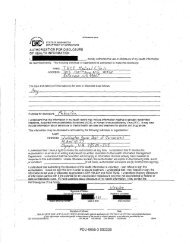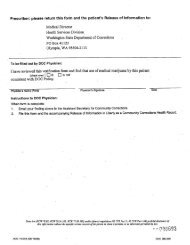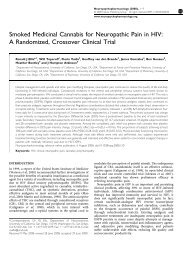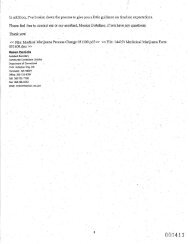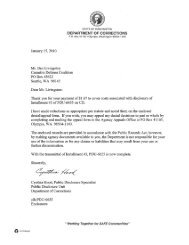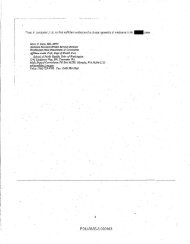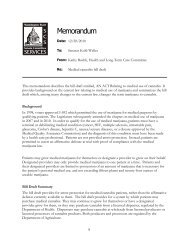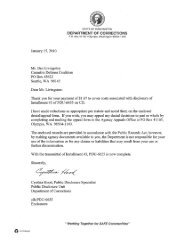Figure 1. Timel<strong>in</strong>e of procedures <strong>associated</strong>with first and last smok<strong>in</strong>g sessions(day 1 and day 5) and illustrationof mark<strong>in</strong>g of borders of hyperalgesiaon the forearm surround<strong>in</strong>g the stimulatedarea. Procedures: LTS longthermal stimulation—upper arm (45 °Cfor 1 m<strong>in</strong>ute); forearm heat: 45 °C for 5m<strong>in</strong>utes; forearm capsaic<strong>in</strong>: 0.075% for30 m<strong>in</strong>utes; VAS Visual AnalogScale—Rat<strong>in</strong>g of current neuropathicpa<strong>in</strong>; map map area of secondaryhyperalgesia (brush and von Frey);RK rek<strong>in</strong>dl<strong>in</strong>g—forearm (40 °C for5 m<strong>in</strong>utes).at least 30 mm on the 100 mm visual analog scale dur<strong>in</strong>g theoutpatient pre-<strong>in</strong>tervention phase. Patients were <strong>in</strong> stable health,were without current substance abuse (<strong>in</strong>clud<strong>in</strong>g tobacco), andfollowed a stable medication regimen for pa<strong>in</strong> and <strong>HIV</strong> for at least8 weeks prior to enrollment. Pa<strong>in</strong>ful <strong>HIV</strong>-SN was confirmed bysymptoms of symmetric distal pa<strong>in</strong> or dysesthesias <strong>in</strong> the lowerextremities for at least 2 weeks, comb<strong>in</strong>ed with absent or depressedankle reflexes or <strong>sensory</strong> loss of vibration, p<strong>in</strong>, temperature,or touch on exam<strong>in</strong>ation by the study neurologist (C.A.J.). Afamily history of poly<strong>neuropathy</strong>, <strong>neuropathy</strong> due to causes otherthan <strong>HIV</strong> or dideoxynucleosides, and use of isoniazid, dapsone, ormetronidazole with<strong>in</strong> 8 weeks prior to enrollment were exclusionary.<strong>HIV</strong> <strong>neuropathy</strong> was def<strong>in</strong>ed as onset of symptoms withoutconcomitant dideoxynucleoside antiretroviral therapy and nucleoside<strong>neuropathy</strong> as symptom onset dur<strong>in</strong>g dideoxynucleosidetreatment. Subjects with <strong>HIV</strong> <strong>neuropathy</strong> whose symptoms worsenedon dideoxynucleoside agents were considered to have both<strong>HIV</strong> and nucleoside <strong>neuropathy</strong>.All patients were required to have prior experience smok<strong>in</strong>gcannabis (def<strong>in</strong>ed as six or more times <strong>in</strong> their lifetime), so thatthey would know how to <strong>in</strong>hale and what neuropsychologic effectsto expect. Current users were asked to discont<strong>in</strong>ue any cannabisuse prior to study admission.The study was approved by the Institutional Review Board atthe University of California San Francisco, the Research AdvisoryPanel of California, the Drug Enforcement Adm<strong>in</strong>istration, theFood and Drug Adm<strong>in</strong>istration, and the National Institute onDrug Abuse. Written <strong>in</strong>formed consent was obta<strong>in</strong>ed from all patients.The trial was monitored by an <strong>in</strong>dependent Data SafetyMonitor<strong>in</strong>g Board (DSMB) established by the University of CaliforniaCenter for Medic<strong>in</strong>al <strong>Cannabis</strong> Research.Study medication. The National Institute on Drug Abuse providedidentically appear<strong>in</strong>g pre-rolled cannabis and placebo cigarettesweigh<strong>in</strong>g on average 0.9 g. Active cannabis cigarettesconta<strong>in</strong>ed 3.56% delta-9-tetrahydrocannab<strong>in</strong>ol (delta-9-THC), andidentical-appear<strong>in</strong>g placebo cannabis cigarettes from which theactive components had been extracted conta<strong>in</strong>ed 0% delta-9-THC.The cigarettes were kept <strong>in</strong> a locked and alarmed freezer untilthey were dispensed to a locked freezer <strong>in</strong> the San FranciscoGeneral Hospital General Cl<strong>in</strong>ical Research Center where the<strong>in</strong>patient study was conducted. The frozen cigarettes were rehydratedovernight <strong>in</strong> a humidifier. Patients were housed <strong>in</strong> a roomwith a fan ventilat<strong>in</strong>g to the outside. Research staff monitoredpatients dur<strong>in</strong>g smok<strong>in</strong>g sessions, weighed the cannabis cigarettesimmediately before and after they were adm<strong>in</strong>istered to patients,and returned all leftover material to the pharmacy. To maximizestandardization of <strong>in</strong>haled doses, patients followed a uniform puffprocedure. 16Study timel<strong>in</strong>e and procedures. The study had four phases: a7-day outpatient pre-<strong>in</strong>tervention phase (study days –9 to –3) toestablish eligibility; a 2-day <strong>in</strong>patient lead-<strong>in</strong> phase (study days –2and –1) <strong>in</strong> which patients were acclimated to the <strong>in</strong>patient GeneralCl<strong>in</strong>ical Research Center sett<strong>in</strong>g and basel<strong>in</strong>e measurementswere obta<strong>in</strong>ed; a 5-day <strong>in</strong>patient <strong>in</strong>tervention phase (study days 1to 5); and a 7-day outpatient post-<strong>in</strong>tervention phase (study days 6to 12) dur<strong>in</strong>g which patients cont<strong>in</strong>ued to record pa<strong>in</strong> rat<strong>in</strong>gs eachday.Randomization (1:1) to cannabis or placebo cigarettes wascomputer-generated by the study statistician and managed by an<strong>in</strong>dependent research pharmacist. Treatment was double-bl<strong>in</strong>d.After hospital admission on day –2, patients were not allowed toleave the hospital or receive visitors. Patients smoked their firstcigarette at 2 PM on day 1, and their last cigarette at 2 PM on day5. Pa<strong>in</strong> model procedures and repeated rat<strong>in</strong>gs of chronic pa<strong>in</strong>were <strong>in</strong>corporated <strong>in</strong>to the first and last smok<strong>in</strong>g session, asshown <strong>in</strong> figure 1. On the <strong>in</strong>terven<strong>in</strong>g study days, patientssmoked, as tolerated, one cigarette three times daily (8:00 AM, 2:00PM, 8:00 PM). Preadmission analgesics were cont<strong>in</strong>ued throughoutthe study.Primary outcome measure: Daily diary pa<strong>in</strong> VAS. Beg<strong>in</strong>n<strong>in</strong>gwith the outpatient pre-<strong>in</strong>tervention phase and extend<strong>in</strong>g throughthe post-<strong>in</strong>tervention phase, patients completed a diary at 8 AMeach morn<strong>in</strong>g to rate their chronic neuropathic pa<strong>in</strong> dur<strong>in</strong>g thepreced<strong>in</strong>g 24 hours on a 100 mm visual analog scale (VAS) labeled“no pa<strong>in</strong>” at 0 mm and “worst pa<strong>in</strong> imag<strong>in</strong>able” at 100 mm.Secondary outcome measures: Day 1 and day 5 smok<strong>in</strong>g sessions.Rat<strong>in</strong>gs of chronic neuropathic pa<strong>in</strong> VAS. To assess the immediateeffect of smoked cannabis on chronic neuropathic pa<strong>in</strong>, patientsrated their current pa<strong>in</strong> at 40-m<strong>in</strong>ute <strong>in</strong>tervals three timesbefore and three times after smok<strong>in</strong>g the first and last cigaretteon a 100-mm VAS (figure 1). In the pilot study, we observed rapid<strong>in</strong>creases <strong>in</strong> plasma levels of delta-9 THC after 2 m<strong>in</strong>utes (mean 96.8 ng/mL; 95% CI 48.7, 145.0) with rapid decl<strong>in</strong>es after 1hour (mean 6.2 ng/mL; 95% CI 3.3, 9.2). This study wasdesigned so these measures were collected with<strong>in</strong> the time of peakplasma levels.LTS procedure. The long thermal stimulation procedure(LTS) was used to assess acute analgesic effects. Sk<strong>in</strong> on thenon-dom<strong>in</strong>ant shoulder was heated us<strong>in</strong>g a computer-controlledPeltier device with a 15.7-cm 2 surface area thermode (TSA 2001,Medoc, Israel). 17,18 The probe is held aga<strong>in</strong>st the sk<strong>in</strong> at a hold<strong>in</strong>gtemperature of 32 °C and then heated to 45 °C at a l<strong>in</strong>ear rate. Onreach<strong>in</strong>g 45 °C, pa<strong>in</strong> is then rated cont<strong>in</strong>uously us<strong>in</strong>g an electronicvisual analog scale with a 100-mm l<strong>in</strong>ear track for 1 m<strong>in</strong>ute beforethermode removal. The LTS procedure was performed twice beforeand three times after smok<strong>in</strong>g.Heat/capsaic<strong>in</strong> sensitization model. The heat/capsaic<strong>in</strong> sensitizationmodel was used to assess anti-hyperalgesic effects by<strong>in</strong>duc<strong>in</strong>g neuronal sensitization sufficient to produce an area ofcutaneous secondary hyperalgesia that can be mapped andquantified. 14,15,17-19 Heat/capsaic<strong>in</strong> sensitization was <strong>in</strong>duced on a22.8 cm 2 stimulation site on the forearm by us<strong>in</strong>g the thermode toheat the sk<strong>in</strong> to 45 °C for 5 m<strong>in</strong>utes followed by treat<strong>in</strong>g thestimulation site with topical capsaic<strong>in</strong> cream (0.075%, Capzais<strong>in</strong>HP, Chattem Inc.; Chattanooga, TN) for 30 m<strong>in</strong>utes. Cutaneoushyperalgesia was ma<strong>in</strong>ta<strong>in</strong>ed by heat<strong>in</strong>g the stimulation site to 40°C for 5 m<strong>in</strong>utes (rek<strong>in</strong>dl<strong>in</strong>g procedure) at 40-m<strong>in</strong>ute <strong>in</strong>tervals.After each rek<strong>in</strong>dl<strong>in</strong>g, areas of secondary hyperalgesia were quantifiedwith a 1-<strong>in</strong>ch foam brush and with a 26-g von Frey hair (amildly noxious p<strong>in</strong>-like sensation) by stimulat<strong>in</strong>g along l<strong>in</strong>ear rostral–caudaland lateral–medial paths around the stimulation site<strong>in</strong> 5-mm steps at 1-second <strong>in</strong>tervals. Start<strong>in</strong>g well outside thehyperalgesic area and cont<strong>in</strong>u<strong>in</strong>g toward the treated sk<strong>in</strong> area,the sk<strong>in</strong> was marked where patients reported a def<strong>in</strong>ite change <strong>in</strong>516 NEUROLOGY 68 February 13, 2007
sensation (such as burn<strong>in</strong>g, tenderness, or more <strong>in</strong>tense prick<strong>in</strong>g).The distances from the center of the stimulation site were thenmeasured and surface area calculated. The first (basel<strong>in</strong>e) rek<strong>in</strong>dl<strong>in</strong>gwas performed before smok<strong>in</strong>g and rek<strong>in</strong>dl<strong>in</strong>g was repeatedthree times after smok<strong>in</strong>g.Safety, side effects, and mood rat<strong>in</strong>gs. On study days –1, 2,and 5, patients completed the Profile of Mood States to assesstotal mood disturbance and subscales of tension-anxiety,depression-dejection, anger-hostility, vigor-activity, fatigue<strong>in</strong>ertia,and confusion-bewilderment. 20 Side effects of anxiety, sedation,disorientation, paranoia, confusion, dizz<strong>in</strong>ess, and nauseawere patient-rated on a 0 to 3 scale (none, mild, moderate, severe)at 9:00 AM, 3:00 PM, and 9:00 PM dur<strong>in</strong>g the entire hospital stay.Adverse events were graded us<strong>in</strong>g the NIH Division of AIDS tablefor grad<strong>in</strong>g severity of adult adverse experiences. 21Statistical analysis. Study sample size was based on an openlabelpilot trial <strong>in</strong> 16 patients with <strong>HIV</strong>-SN of very similar design.22 The mean reduction <strong>in</strong> pa<strong>in</strong> was 30.1% (95% CI: 61.2,1.0). Ten pilot patients (62%) had a greater than 30% decrease <strong>in</strong>their daily pa<strong>in</strong>, the prespecified criterion of cl<strong>in</strong>ically mean<strong>in</strong>gfulpa<strong>in</strong> relief. 23 Apply<strong>in</strong>g the same variances to a randomized,placebo-controlled trial and conservatively estimat<strong>in</strong>g that 50% ofcannabis patients and 13% of placebo patients would meet the30% pa<strong>in</strong> reduction criterion yields a sample size of 48 patientswith an alpha of 0.05 and a beta of 0.20.Statistical analyses were conducted on a modified <strong>in</strong>tent-totreat(ITT) sample. All patients who rema<strong>in</strong>ed <strong>in</strong> the study at eachtime po<strong>in</strong>t were <strong>in</strong>cluded <strong>in</strong> the analyses. The primary outcomewas the proportion of patients <strong>in</strong> the cannabis and placebo groupswho experienced at least a 30% reduction <strong>in</strong> daily diary pa<strong>in</strong> levelfrom basel<strong>in</strong>e (average of the two daily diary pa<strong>in</strong> levels rated at 8AM on study day 1 and study day 1) to end-of-treatment (averageof study days 4 and 5). p Values were obta<strong>in</strong>ed us<strong>in</strong>g 2 test for 2by 2 tables.The co-primary outcome variable was the percent change <strong>in</strong>pa<strong>in</strong> from basel<strong>in</strong>e. Percent change <strong>in</strong> each group was not normallydistributed; therefore, the nonparametric Mann-Whitneytest was used to compare percent change <strong>in</strong> pa<strong>in</strong> across studygroups. Pa<strong>in</strong> reduction was also modeled as a function of groupand time us<strong>in</strong>g a repeated measures model (generalized estimat<strong>in</strong>gequations). All available patient <strong>in</strong>formation, <strong>in</strong>clud<strong>in</strong>g <strong>in</strong>formationon patients who later withdrew from the study, was<strong>in</strong>cluded <strong>in</strong> this model. The data were fitted us<strong>in</strong>g time squared toallow for non-l<strong>in</strong>earity <strong>in</strong> the relationship between group andtime. To adjust for potentially confound<strong>in</strong>g patient characteristics,we controlled for age, gender, pre-study ongo<strong>in</strong>g use of cannabis(yes or no), cause of <strong>neuropathy</strong>, and basel<strong>in</strong>e daily pa<strong>in</strong>.Secondary outcome variables collected while smok<strong>in</strong>g the firstcigarette on day 1 and the last cigarette on day 5 consisted ofpercent change (relative to pre-smok<strong>in</strong>g basel<strong>in</strong>e for that session)<strong>in</strong> 100 mm VAS rat<strong>in</strong>gs of chronic neuropathic pa<strong>in</strong>, pa<strong>in</strong>fulnessof the LTS procedure, and areas of secondary hyperalgesia producedby the heat/capsaic<strong>in</strong> sensitization model to brush and vonFrey hair stimuli. For each of these repeated measures, the areaunder the curve (AUC) for percent change <strong>in</strong> pa<strong>in</strong> or area ofsensitization was computed relative to pre-smok<strong>in</strong>g basel<strong>in</strong>e values(or the average of the pre-smok<strong>in</strong>g values if multiple measurementswere available). The total AUC was standardized asaverage percent change per hour by divid<strong>in</strong>g each AUC by 60.Differences <strong>in</strong> AUC were compared us<strong>in</strong>g Mann-Whitney tests asthese data were not normally distributed.Additional secondary outcome analyses of the percent change<strong>in</strong> total mood disturbance and percent change <strong>in</strong> the six subscalesof the Profile of Mood States was analyzed us<strong>in</strong>g <strong>in</strong>dependent ttests or Mann-Whitney tests if the data were not normally distributed.Side effect rat<strong>in</strong>gs were compared us<strong>in</strong>g repeated measuresmodels (generalized estimat<strong>in</strong>g equations), us<strong>in</strong>g a negative b<strong>in</strong>omialdistribution to allow for rare events and over-dispersed dataand adjusted for differences <strong>in</strong> mean recorded side effects acrossstudy days and time of day of measurement.Role of the fund<strong>in</strong>g source. The University of California Centerfor Medic<strong>in</strong>al <strong>Cannabis</strong> Research provided assistance with obta<strong>in</strong><strong>in</strong>gnecessary regulatory approvals, data quality monitor<strong>in</strong>g,and establish<strong>in</strong>g the study’s Data Safety Monitor<strong>in</strong>g Board.Results. Study patients. A total of 223 patients wereassessed for eligibility between May 2003 and May 2005Figure 2. Flow of participants through the trial.(figure 2) and 55 <strong>in</strong>dividuals were enrolled. Of these, 27were randomized to cannabis cigarettes and 28 were randomizedto placebo cigarettes. One patient withdrew dur<strong>in</strong>gthe <strong>in</strong>patient <strong>in</strong>tervention phase prior to smok<strong>in</strong>g thefirst cigarette, and four additional patients withdrew priorto completion of the <strong>in</strong>patient phase, leav<strong>in</strong>g 25 patients <strong>in</strong>each group who completed the entire study. All smok<strong>in</strong>gsessions were observed by research staff and completed perprotocol.Thirty randomized patients completed the experimentalpa<strong>in</strong> model portion of the study (14 cannabis, 16 placebo).Of the 25 patients who did not fully participate <strong>in</strong> thisportion of the study, 17 could not tolerate the pa<strong>in</strong>ful stimulationwhen tested dur<strong>in</strong>g the outpatient pre-<strong>in</strong>terventionphase, one developed a blister, one discont<strong>in</strong>ued prior tostudy day 1, and six did not meet eligibility criteria for thepa<strong>in</strong> model portion (extensive tattoo<strong>in</strong>g <strong>in</strong> one and heatpa<strong>in</strong> detection threshold above 47 °C <strong>in</strong> five).The patients randomized to cannabis and placebo cigaretteswere similar with regard to demographic and basel<strong>in</strong>echaracteristics (table 1). Patients were predom<strong>in</strong>antlymen with 14 years of <strong>HIV</strong> <strong>in</strong>fection and 7 years of peripheral<strong>neuropathy</strong>. Neuropathy was believed to be secondaryto antiretroviral medications <strong>in</strong> the majority of patients <strong>in</strong>both groups. Over half of patients <strong>in</strong> each group used concomitantmedications for pa<strong>in</strong>, with about one quarter ofeach group us<strong>in</strong>g more than one type of concomitant medication.The most frequently used concomitant medicationwas gabapent<strong>in</strong> (15 patients) followed by opioids (14patients).Primary outcome measure. Median daily pa<strong>in</strong> rat<strong>in</strong>gsfor the two groups throughout the entire study are shown<strong>in</strong> figure 3. Basel<strong>in</strong>e (average of day 1 and day 1) dailydiary pa<strong>in</strong> rat<strong>in</strong>gs were similar (cannabis median 52, <strong>in</strong>terquartilerange [IQR] 38, 71; placebo median 57,IQR 40, 74). Among those who completed the study, 13of 25 patients randomized to cannabis cigarettes had30% reduction <strong>in</strong> pa<strong>in</strong> from basel<strong>in</strong>e to end of treatmentvs 6 of 25 patients receiv<strong>in</strong>g placebo cigarettes (52% vs24%; difference 28%, 95% CI 2% to 54%, p 0.04). Themedian reduction <strong>in</strong> chronic neuropathic pa<strong>in</strong> on the dailydiary VAS was 34% (IQR 71, 16) <strong>in</strong> the cannabisgroup and 17% <strong>in</strong> the placebo group (IQR 29, 8; difference 18%; p 0.03, Mann-Whitney test). In the multivariablerepeated measures model, which analyzedavailable data from all randomized patients, the estimatedgroup difference was slightly larger than the observed dif-February 13, 2007 NEUROLOGY 68 517




